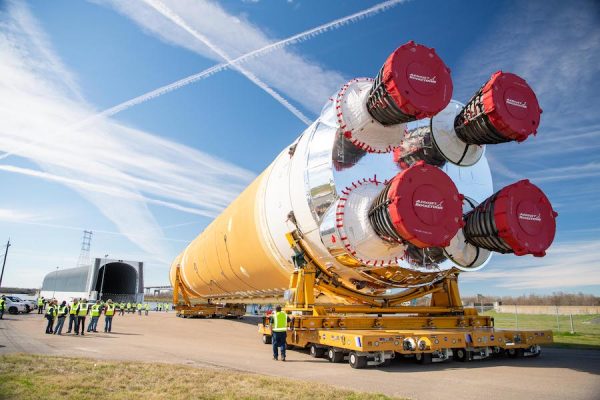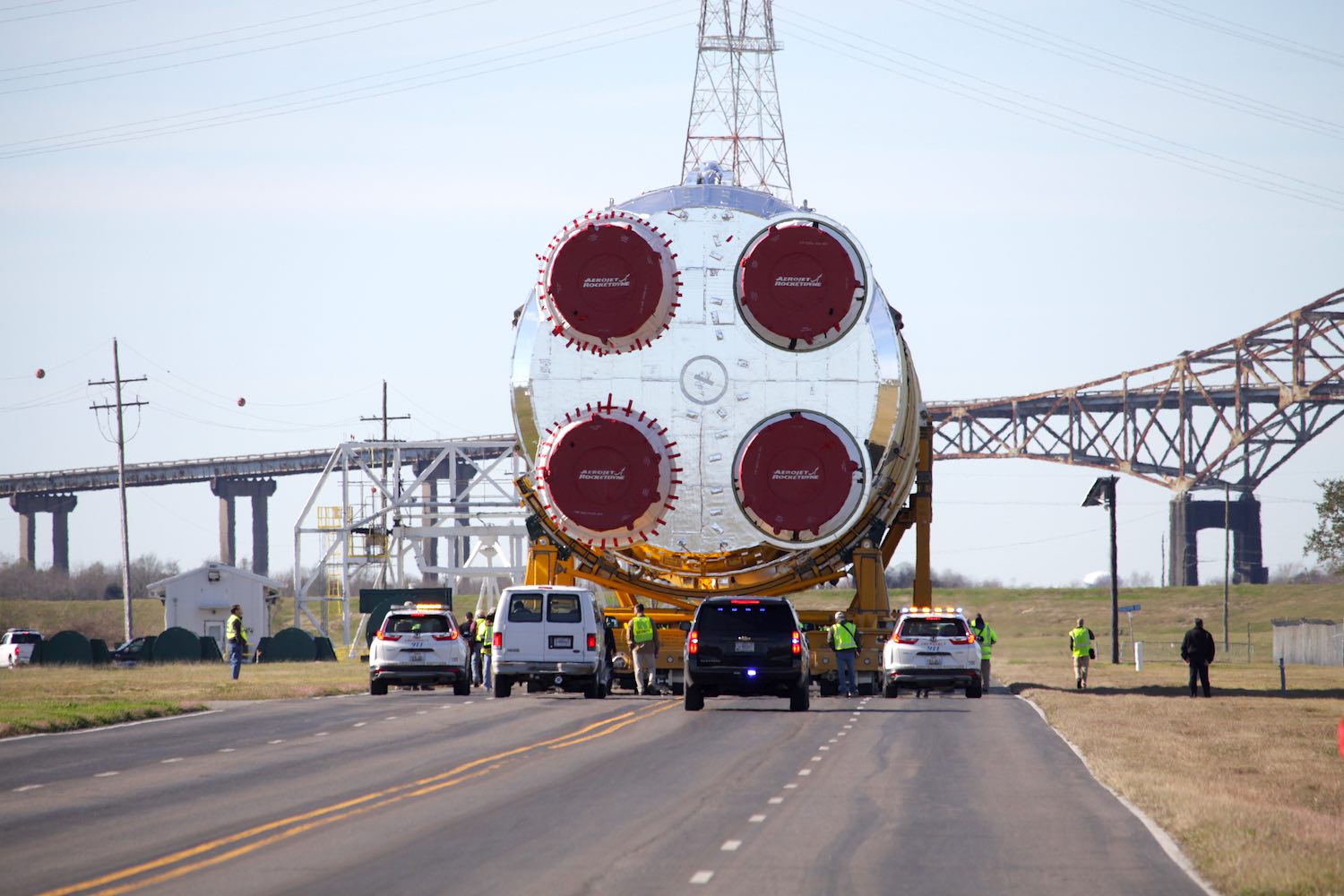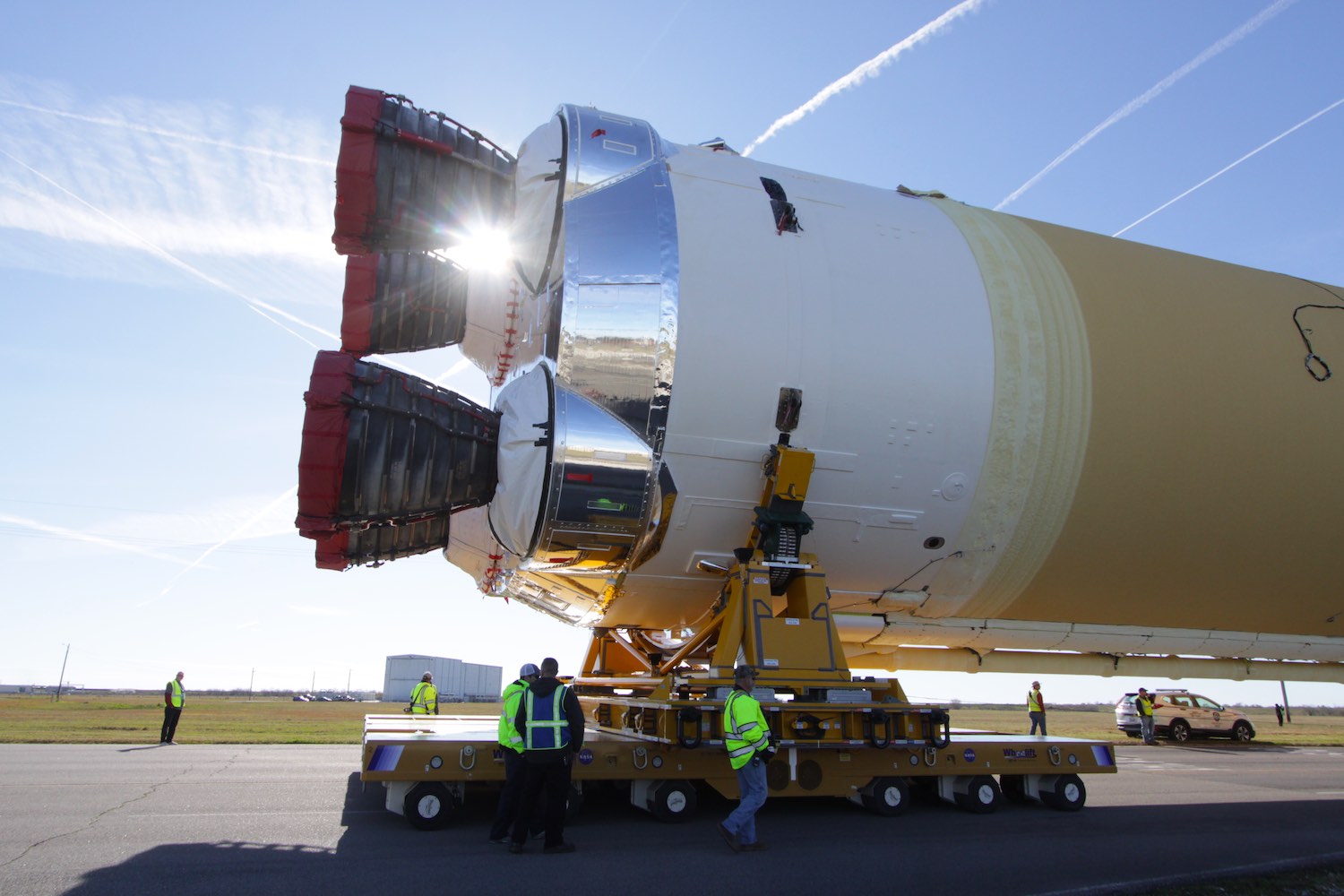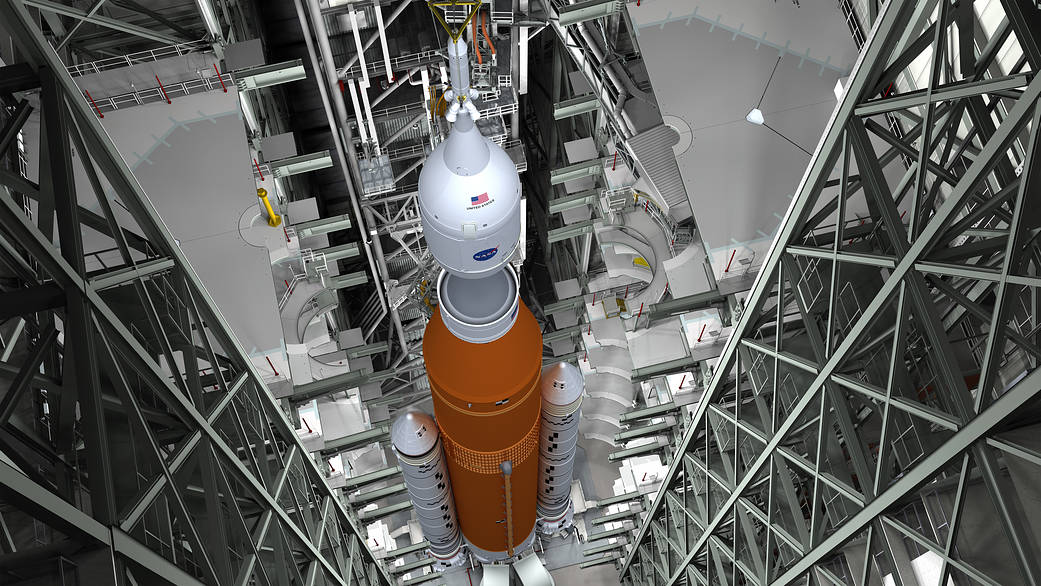NASA, Boeing aim to deliver first SLS core stage to Kennedy Space Center by this fall – Spaceflight Now

After years of delays, the core stage for NASA’s first Space Launch System moon rocket rolled out of its New Orleans factory Wednesday, heading for a NASA site in Mississippi for a test-firing before engineers hope to ship the rocket to its Florida launch base by this fall.
A target launch date for the first SLS test flight, which will carry an unpiloted Orion crew capsule beyond the moon, is expected in 2021. But more specific schedule remains uncertain.
Teams loaded the first fully-assembled SLS core stage inside NASA’s Pegasus barge at a wharf adjoining NASA’s Michoud Assembly Facility after a 1.3-mile (2.1-kilometer) trip from the rocket’s factory, the same location where previous generations of technicians manufactured the massive first stage of the Saturn 5 moon rocket and the external fuel tank for the space shuttle.
Covered in orange insulating foam, the core stage is fitted with four Aerojet Rocketdyne RS-25 main engines. Each of the reusable hydrogen-fueled engines powered multiple space shuttle missions, but they will be discarded with the SLS core stage, which is only designed for a single flight.
Built by Boeing, the SLS core stage emerged from its factory at Michoud — located on the east side of New Orleans — Wednesday morning with a bit of New Orleans pomp. Some SLS team members wore shiny bead necklaces, and a “second line” New Orleans drum and brass band accompanied the rocket on the trek out of the factory.
“That’s a whole lot of rocket,” said Jim Morhard, NASA’s deputy administration. “We are talking about a national asset.”
The 212-foot-long (64.6-meter), 27.6-foot-wide (8.4-meter) SLS core stage has the same diameter as the shuttle’s fuel tank. It weighs about 188,000 pounds (85 metric tons) empty, and will weigh around 2.3 million pounds (more than 1,000 metric tons) fully fueled.
The first SLS core stage, when completed, is more than 6,000 pounds lighter than officials originally expected, according to John Shannon, vice president and general manager for the SLS program at Boeing.
NASA started working on the SLS program in 2011, following the cancellation of the Constellation moon program. The development timeline at that time called for the first launch of the SLS in 2017.
Since 2011, NASA has spent more than $15 billion on developing the Space Launch System.
Development of the SLS was first geared toward NASA’s push to send humans to Mars under the Obama administration, then redirected under the umbrella of Artemis program started by the Trump administration aimed at returning humans to lunar surface in the 2020s.
Despite criticism stemming from the cost of the SLS and repeated schedule slips, NASA and Boeing officials this week said they have a renewed focus on delivering the core stage to the Kennedy Space Center for launch preparations by the end of this year.
“Seven years ago, you had preliminary design and no real factory, and here she is,” said Jim Chilton, senior vice president of Boeing’s space and launch division. “This is not a trivial accomplishment. In the last year-and-a-half, the NASA/Boeing team invented how to build one of these things, just absolutely invented it on the (factory) floor.”
In response to the most recent series of delays, which were primarily caused by issues with assembling the first core stage engine section, Boeing reconfigured the work flow inside the Michoud Assembly Facility, opting to connect the stage’s liquid hydrogen and liquid oxygen tanks before adding the engine section in a horizontal configuration inside the factory.
“I think there was an expectation that Boeing built space station, albeit decades ago, Boeing builds airplanes — they ought to be able to do this. Why are they having problems?” said John Honeycutt, a veteran NASA program manager who leads the space agency’s SLS effort at the Marshall Space Flight Center. “A rocket’s just different. We basically just had an empty factory for them. I think there was a mindset that they’ve got a facility, they’ve got a design, why can’t they just build the rocket?
“If you look back over the past 12-to-18 months, they’ve done a pretty dang good job of holding schedule, Honeycutt said.
The core stage’s four engines are upgraded with modernized electronics and rated for slightly higher throttle settings than they were in the shuttle program.

The RS-25 engines will be ignited later this year on a test stand at the Stennis Space Center in southern Mississippi during a “green run” test series designed to confirm the rocket works as designed when loaded with more than 700,000 gallons of super-cold liquid hydrogen and liquid oxygen propellants.
The four RS-25 engines will power up to full throttle to generate nearly 2 million pounds of thrust during the hotfire test.
“This vehicle, as a result of the human-rating of it, it’s gone through an extremely rigorous series of tests,” Shannon said. “That will culminate with the green run, where we do those tests at cryogenic conditions and finally end up with the full mission duty cycle hotfire.
“So by the time we take this vehicle to the Kennedy Space Center, it will be an extremely well-understood vehicle ,and we have really high confidence in flying it, and for the second flight, (with) crew.”
Before the hotfire at Stennis, crews must first raise the core stage vertical and hoist it into the enormous B-2 test stand.
Technicians will make final connections between the core stage’s liquid hydrogen tank, which sits below the rocket’s first stage liquid oxygen tank, and the four RS-25 engines. Those fittings are easier to secure while the rocket is vertical, and the change at Michoud to install the engine section horizontally forced officials to put off the hydrogen feed line connections until the core stage is at Stennis.
Engineers will also perform a modal test on the core stage to measure the resonant frequency of the rocket. That data will be fed into models to help predict how the rocket will fly.
Once the core stage is firmly attached to the B-2 test stand, engineers will switch on the rocket’s avionics and begin powering up control computers, instrumentation and other equipment for the green run test.
Then test teams will load super-cold liquid hydrogen and liquid oxygen propellants into the core stage for the first time.
Subjecting the intricate plumbing inside the core stage to cryogenic temperatures — minus 423 degrees (minus 253 degrees Celsius) in the case of liquid hydrogen, and minus 298 degrees Fahrenheit (minus 183 degrees Celsius) for liquid oxygen — will stress the propellant tanks and propulsion system.
“Filling everything with cryo is huge because that’s the first time you have your tanks moving the way they’re going to move when they’re filled with cryo fluid,” said Alex Cagnola, a propulsion engineer at NASA’s Marshall Space Flight Center, which manages the SLS program. “You’re testing all your joints. You’re testing how everything basically acts under a cryogenic environment.”
Shannon agreed, highlighting the core stage’s response to cryogenic propellant as a big unknown.
“We did a very comprehensive set of functional testing on the vehicle (before it left the factory), and that included pressure tests, seal checks ,all the electrical tests we could think of, software checks and things like that,” Shannon said. “And the vehicle came through really with flying colors. We found no real issues with the design or the way it was produced.
“But things change when you get down at cryogenic temperatures, and as we saw after our experience with the shuttle, you can end up having systems perform differently,” said Shannon, a former NASA flight director and space shuttle program manager.
Teams will check for leaks once the rocket is loaded with more than 730,000 gallons of super-cold propellants.
“The next big unknown as a program is when we put the cryogenic liquids in the oxygen tank and the hydrogen tank, and we look at the plumbing and all the systems and make sure that they remain tight, and that they perform as expected through our qualification test,” Shannon told reporters Wednesday. “We have high confidence that they will, but until you see it in an integrated fashion, you don’t really know.”

Assuming the fueling demonstration goes well, managers will give the go-ahead a few weeks later to fuel the core stage again for the eight-minute test-firing of the RS-25 engines.
Honeycutt said the hotfire test could happen in June, assuming teams encounter no major problems.
Shannon said the test-firing will satisfy engineering requirements if the engines run for a little more than two minutes. If a ground system problem forces a premature cutoff of the engines after that point, managers could decide to declare the test complete and begin preparations to transport the rocket to Florida.
If a problem on the rocket itself causes an engine shutdown, managers will likely want to perform another hotfire test at Stennis before shipping the core stage to the Kennedy Space Center.
“One big difference with the way SLS is built than with shuttle is we take a bleed off the hydrogen exhaust to be able to drive the hydraulic power units (for the first stage’s thrust vector control engine gimbal and steering system),” Shannon said. “We also take that same bleed coming off the connection to build the hydrogen tank pressure.
“When the hydrogen tank is at a level of about two-thirds down, we’re going to really aggressively gimbal the four engines, it’s going to put a lot of pressure on the ability to continue to feed those hydraulic power units and provide sufficient pressure to the liquid hydrogen tank. It’s one of the major tests, and the reason we’re doing the green run.
“That’s a very different thing. You wouldn’t it see in flight, but it gives us a very good stress test on that part of the design of the vehicle to show we can keep the tank pressurized while we’re aggressively gimbaling at a very low level in the liquid hydrogen tank.”
Technicians will inspect the core stage after the hotfire test for damage to its foam insulation, which is made of different materials than the foam used on the space shuttle external tank. Engine inspections and refurbishment will also be required after the test-firing.
“There’s a little bit of refurbishment that happens after hotfire,” said Cagnola, a NASA propulsion engineer. “Aerojet Rocketdyne has to take a look at their engines. They assess all the nozzles. They assess all the parts in there. They have to remove the aluminum tape on the boat-tail after hotfire. They’ll have to asses the condition of the (paint) under there. They’ll have to assess all the outside and inside components.”
NASA and Boeing managers plan to perform some of the refurbishment on the core stage after it is delivered to Kennedy, where technicians will have a more controlled environment to perform their work inside the Vehicle Assembly Building, rather than in the open on the B-2 test stand at Stennis.
“If everything went perfectly, and we didn’t have any kind of weather issues on the stand that would halt work, if the vehicle performs completely as expected and we didn’t have any refurbishment, we’d be out (of Stennis) probably in the late summer timeframe, the July/August timeframe,” Shannon said.
If teams are Stennis have to contend with inclement weather, or some repairs are needed after the test-firing, the rocket could be delivered to Kennedy later in the year, Shannon said.
“The range I think would be July/August if everything goes perfectly, to the October timeframe if we deal with the typical weather or the typical damage that happens to things like the thermal protection system after that eight-minute firing,” Shannon said.
Once at the Kennedy Space Center in Florida, the core stage will join two side-mounted solid-fueled boosters — also using modified space shuttle technology — and an upper stage derived from United Launch Alliance’s Delta 4-Heavy rocket.
The SLS will blast off from pad 39B at the Florida spaceport some time in 2021. A target launch date is still under review after a series of delays have pushed back the SLS’s inaugural test flight from its original schedule in 2017.
The first launch, designated Artemis 1, will carry NASA’s Orion crew capsule on an unpiloted flight into lunar orbit and back to Earth. Boeing teams at Michoud are building a second SLS core stage for the Artemis 2 mission, which could blast off in 2022 or 2023 to carry another Orion vehicle with four astronauts around the moon and back.
The Artemis program’s third mission, planned for 2024, could include an attempt to land astronauts on the moon, a five-year goal set by Vice President Mike Pence last year.
In parallel with the development of the SLS, NASA is kicking off procurement of a human-rated lunar lander. The agency is expected to select multiple industry teams in the coming months to begin developing a moon lander, before choosing a single design to attempt a landing in 2024, and another team to try for a landing in 2025.
NASA is also planning to built a mini-space station lunar orbit called the Gateway to serve as a research platform and waypoint for crews transiting between Earth and the lunar surface.
The ULA-built upper stage for the first SLS mission is in storage at the Kennedy Space Center, waiting for arrival of the core stage. All 10 segments of the two solid rocket boosters for the Artemis 1 launch are fueled with their pre-packed propellant at a Northrop Grumman facility in Utah, awaiting NASA’s go-ahead for their railroad journey to Florida.

The SLS will be stacked inside Vehicle Assembly Building high bay atop a towering mobile launch platform, which will carry the rocket from the VAB to pad 39B at the Florida launch base, riding one of NASA’s Apollo-era huge diesel-powered crawler transporters.
Meanwhile, production of the next two SLS core stages is underway at Michoud.
Both propellant tanks for the second SLS core stage — for the rocket’s first crewed launch — have been welded and are undergoing testing before they receive their insulation. Outfitting of the engine section has also started at Michoud.
Shannon said Boeing is targeting completion of the fully-assembled core stage for the Artemis 2 mission in March 2022. NASA does not plan to perform a green run test on future SLS core stages, so the rocket will be delivered directly from Louisiana to the Kennedy Space Center.
Parts for the Artemis 3 core stage are also being readied at Michoud.
Meanwhile, Boeing engineers at Michoud expect to resume work on a new four-engine upper stage for future SLS missions. The new Exploration Upper Stage, which will improve the SLS lift capability, could be ready in time to replace the single-engine ULA-built upper stage for the Artemis 4 mission in the 2025 timeframe.
“We throttled back the funding for EUS as a result of the delays on the core stage, primarily,” Honeycutt said. “We have gotten favorable appropriations pretty much every year, so … given that we get favorable appropriations, we’re going to start ramping up on EUS this year.
“John (Shannon from Boeing) thinks he can get an EUS out in the ’24 timeframe … I’m a little less positive on it than he is,” Honeycutt said. “I think it’s more like in ’25.”
Email the author.
Follow Stephen Clark on Twitter: @StephenClark1.






